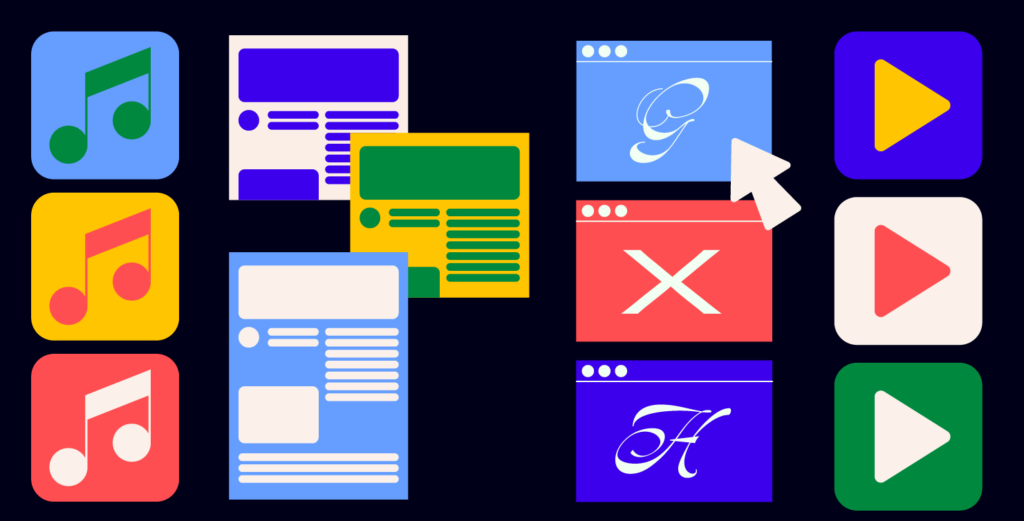Nearly 70% of marketers report that content marketing generates leads. Another 72% state that content marketing is useful for educating audience members about a product, service, or brand. With statistics like that, you can’t afford not to have an in-depth content marketing strategy. Join us as we take you through the steps involved in creating high-quality content that delights audience members and helps you reach your business goals.
What Are the Benefits of Having a Content Marketing Strategy?
Content marketing is helpful for increasing brand awareness, generating leads, and tailoring your marketing efforts to multiple buyer personas. To enjoy these benefits, however, you must produce high-quality content that addresses customer pain points and positions your brand in the best possible light.
To take the guesswork out of planning, creating, distributing, and monitoring your content, we put together this guide to developing a killer content marketing strategy for 2024 and beyond.
Step 1: Create a Content Calendar

A content calendar (editorial calendar) isn’t just an ordinary calendar filled with appointments. It’s your road map to success with content management. Before you do anything else, pick a content calendar that works for your needs.
One of the most popular formats is the visual calendar, which uses symbols to guide your content marketing efforts. It doesn’t matter what symbols you use, just that you pick icons that make sense and use them consistently. For example, you might want to use a microphone symbol to indicate when you plan to put out a new podcast. If you’re in the market for something simple, you can’t go wrong with a spreadsheet or a table.
What to Include in a Content Calendar
To make your content calendar as useful as possible, make sure it has room for the following items.
Topics
For best results, be specific about the topics you plan to cover. If you’re promoting a new line of sneakers, for example, you’ll want to go a bit deeper than “shoes.” Try narrower topics like “how to pick the right sneakers for plantar fasciitis” or “choosing an insole to go with your tennis shoes.” Track your ideas in a dedicated marketing planning software, if that helps keep things straight.
Keywords
These are the keywords you want to target with each piece of content. Have your SEO team do in-depth research to make sure you’re using the same keywords that match the search intent as the people in your target audience.
Categories
Categories make it easier to keep your content organized. If you run a health website, your categories might include things like diet, exercise, vitamin supplements, weight loss, and bodybuilding. Notice they all relate to the site’s main topic in some way.
Publication Dates
Note when you plan to publish each piece of content. Your content calendar isn’t set in stone, so you can move content around as needed, but you should have a rough idea of when you need to have each item ready to go. Work backward from these dates to determine when you must complete keyword research, content creation, editing, and other steps.
Headlines
Write down a tentative title for each article, blog post, infographic, podcast episode, and any other content you have planned. There are some great tools out there like CoSchedule's headline analyzer to help you pick the best one.
Content Formats
Content comes in many formats, from blog posts to podcast episodes. It's best to create content in a variety of forms, so make sure your content calendar has room to indicate which type of content you have planned for each topic.
Step 2: Perform a Content Audit

When you’re ready to perform a content audit, the first step is to create a content catalog, or a master list of the content you already have and the content you plan to produce. Here are a few ways to organize your catalog:
- List your content in order of publication date (oldest to newest or newest to oldest).
- Assign each piece of content to a stage of the buyer’s journey.
- Create a new category for each type of content, such as blog posts, podcast episodes, case studies, white papers, and downloadable reports.
- Sort your content catalog by word count. As you track page performance, this can help you determine if you do better with longer or shorter content.
For each piece of content in the catalog, note the title, word count, URL, target keyword, author, and current page rank in Google.
Analyzing Your Existing Content
Now you can use Google Analytics or another tool to collect metrics for your site. Take a look at bounce rates, the number of visitors to each page, your top traffic sources, the average number of page views per session, and other data.
Content to Keep
Once you know how your existing content is performing, decide whether to keep, refresh, or delete each piece. You should keep content that’s relevant to your target audience and performing well in terms of traffic and conversion rates. This includes customer success stories, content that's evergreen, and up-to-date answers to frequently asked questions about your company.
Content to Refresh
If a piece of content is outdated or isn’t performing as well as expected, it’s time to refresh it. For example, if you have a blog post with statistics from 2015, consider updating it with statistics from the past year to make it more timely. Update an article about obsolete technology to explain why the product is obsolete and tell the audience about modern alternatives.
Content to Delete
In a few cases, deleting underperforming content is the best option — but don’t delete things willy-nilly. Review the content carefully and make absolutely sure there’s no way to improve what you have or make it more appealing to audience members. It makes sense to delete content about products you no longer carry, events that took place years ago, and services you no longer offer.
Filling in the Gaps
While you’re organizing your existing content, look for gaps that you can fill in as part of your new content marketing plan. A gap is a missed opportunity to educate audience members about your brand, your products and services, or your industry in general.
Let’s say you launched a new product last year, but your website has no case studies, customer success stories, or other content about the product. That’s a missed opportunity to attract new customers and make them aware of your current offerings.
Once you identify gaps in your digital marketing strategy, update your content calendar to reflect the pieces you want to produce in the coming months. You’ll have to leave some columns blank since you won’t have the URL, publication date, or author’s name available until you create the content.
Step 3: Organize by Types of Content

Now that you know what gaps you need to fill, think about how you’re going to fill them. You have nearly limitless options for content formats, but the best kind of content for your business depends on your goals, audience demographics, and brand image. Here’s a refresher on the types of content you can use to drive organic traffic to your website, generate more leads, and convert visitors into paying customers.
Audio Files
Not everyone has the time or inclination to read long-form articles or keep up with a series of blog posts. If all you have is written content, you may miss out on the opportunity to connect with busy audience members. That’s why your content marketing strategy should include audio.
Podcasts are one of the most popular types of audio content. Although many podcasts focus on pop culture, celebrity sightings, and other nonbusiness topics, plenty of companies are using podcasting to draw attention to their products and services.
If you decide to incorporate audio into your content marketing plan, make sure it’s well-produced. Research from the University of Southern California indicates that audio quality—or lack thereof—influences whether listeners believe what they hear. If you want audience members to take you seriously, give them high-quality audio every time.
Blog Posts
Justin Hall created the first blog in 1994. Initially, blogs served as online journals, letting people share their personal lives with the world. Since then, blog posts have become one of the most popular types of content for building brands and showcasing a company’s products and services.
If your business doesn’t already have a blog, starting one can help you increase website traffic, connect with potential customers, and convert visitors into leads. Blog posts are also helpful for building back links and driving long-term engagement.
Case Studies
A case study documents the implementation of a product or service and explains how the customer benefited from the implementation. This type of content is especially useful in the software industry, as it can be used to show how a piece of software helped a client save time, reduce expenses, or increase revenue.
E-books
The most effective content marketing plans include gated content, or content that’s only available to users who provide their contact information. Think of ungated content as the appetizer and gated content as the main course. You attract potential customers with ungated (freely available) content and then move them deeper into your sales funnel with gated content.
E-books are one of the most popular types of gated content. An e-book is a great way to educate audience members about an important topic and show them that your company has the expertise needed to solve their problems. E-books also include visual content, such as charts and graphs, giving them a higher perceived value than other types of content.
Email Newsletters
If you’re not already using email marketing, you should be. Email allows you to deliver personalized content, collect customer feedback, and drive traffic to your website at a fraction of the cost of print advertising and other marketing.
Email newsletters are especially helpful because recipients have to sign up for them. This indicates at least some level of interest in your products or services, letting you tailor your marketing efforts accordingly.
Infographics
Infographics use visual elements and a minimal amount of text to help users understand complex concepts. For example, if you want to share the results of a survey, you can create an infographic with a pie chart and just a few bullet points to provide context. Looking at a pie chart is much easier than reading a long paragraph and trying to keep track of how participants answered each survey question.
One of the main benefits of using infographics in your content marketing campaign is that they’re shareable. Stakeholders may share your infographics on social media, link to them in emails, or discuss them during meetings, increasing your reach and making more people aware of your brand. To encourage sharing, make sure your infographics are visually appealing and relevant to audience members.
Landing Pages
A landing page is where someone “lands” when they click a link to your website. Each page is designed to stand on its own, making it easy for brand-new visitors to understand what your company does and why they should consider your products or services.
One of the most common ways to use landing pages in your content marketing strategy is to create geo-targeted pages for users in different parts of your service area. This strategy works well for brick-and-mortar businesses that need to attract local customers.
Let’s say you operate a roofing company in Miami, Florida. Much of your content will mention Miami, but “Miami roofing company” is an extremely competitive keyword. By mentioning individual neighborhoods, you have more chances to rank for local terms. You’d want to create landing pages for Downtown Miami, Coconut Grove, Little Havana, South Beach, Brickell, and other areas of the city.
Once you do that, it will be easier for potential customers to find your company when they search for terms like “South Beach roofing company” or “roof repair Little Havana.”
Online Courses
Online courses are highly effective for demonstrating your expertise, making them a popular form of gated content. You can teach a course on almost anything, but before you go to the trouble of creating lessons and recording the content, think about whether a course makes sense for your business.
If you sell a simple product, like shoes, an online course probably isn’t the best marketing tool. Your audience likely doesn’t need a primer on how to put on their shoes in the morning or pick a pair of shoes to go with a favorite outfit.
Online courses work best if you sell complex products or provide some type of professional service. Adobe is a great example of a company that uses online courses effectively. Photoshop has a bit of a learning curve, so Adobe offers several online courses to help users increase their proficiency. Each course also shows off what the software can do, increasing brand loyalty and making it easier for Adobe to connect with audience members.
Product Descriptions
If you run an e-commerce website, detailed product descriptions can help you drive organic traffic to your website and then convert some of those visits into sales. The key to writing effective product descriptions is to focus on the benefits of each product, not just the features.
Features are traits, while benefits are positive outcomes associated with using a product or service. Imagine you’re in charge of marketing for a marriage and family therapy practice. A benefit of using the service would be the opportunity to “build better relationships” or “overcome harmful thought patterns.”
If your company sells a tangible product, you may want to highlight the opportunity to save time, increase revenue, reduce expenses, eliminate stress, increase efficiency, or reduce error rates.
Social Media Posts
Your social media channels are a gold mine for connecting with customers, sharing information about your company, and soliciting customer feedback. Sure, you may get some complaints from customers who didn’t read the product packaging or follow the instructions, but that doesn’t mean social media is a lost cause.
One of the reasons social media is so helpful for content marketing is because it allows you to make direct connections with the people who use your company’s products and services. That means you can survey them about your existing products, solicit suggestions for new products, and ask for feedback about company initiatives.
Social media is also one of the most cost-effective forms of marketing. Once you have an active presence, you can connect with thousands of people in a matter of minutes, all without spending a ton of money on advertising.
Videos
Have you been sleeping on video marketing? If so, it's time to get into it. Video makes it possible to form strong connections with audience members at every stage of the customer journey, making it an essential component of any successful content marketing campaign.
Video educates audience members about your products or services, builds brand awareness, and helps people better understand why your company exists. It’s also highly effective for SEO, as it gives you more opportunities to reach the top of the SERPs for valuable keywords.
If your in-house content team doesn’t have the tools to produce high-quality videos, don’t ignore video marketing completely. Partner with a local videographer to reap the benefits of video without having to hire new staff or invest in equipment.
Webinars
Gone are the days of having to book a hotel ballroom or conference center to deliver a seminar to potential customers. Webinars bring traditional seminars online, eliminating the need to pack up your equipment and travel long distances to connect with people in the market for your products or services.
Webinars are especially effective for companies involved in delivering professional services, such as legal consulting, accounting, and tax preparation. Each webinar positions the speaker as a thought leader, shows off their expertise, and makes audience members more likely to trust their recommendations.
White Papers
A white paper highlights the features and benefits of a product or service without using overly promotional language. Consulting firms and software companies use white papers extensively, but this type of content is helpful for any firm that sells high-value products.
Background white papers, or backgrounders, provide background information on a selected product or service. They’re typically used to help readers evaluate a potential solution to a business problem.
Problem/solution white papers focus on how a specific product or service can help the reader solve a business-related problem. For example, a recruiting company might release a white paper on how its services can help clients reduce out-of-control staffing costs.
Numbered lists provide a specific number of tips or action items on a narrow topic. For example, an accounting company might release a white paper titled “5 Things You Need To Know Before Classifying Someone as an Independent Contractor.”
Step 4: Create Great Content

After all that planning, it’s time to create great content. Here are five tips to make your content marketing plan as effective as possible.
Tailor It to Your Audience
According to the Content Marketing Institute, good content must be relevant to the audience. That means you need to think about who will be viewing the content and make sure it matches their goals, interests, and problems.
What works for one audience might be completely ineffective for another. If your product is designed for female consumers between the ages of 25 and 49, for example, you wouldn’t use the same content for every customer segment. Women in their mid-20s and women nearing 50 have different goals and life experiences, so your content needs to reflect that.
Fine jewelry vs. fashion jewelry is another great example. What’s relevant to someone who can afford $20,000 for a diamond ring probably isn’t relevant to someone looking for a pair of earrings that costs less than $200. You need to tailor your content to the needs of each audience.
Focus on Originality
Google and other search engines have billions of pages of indexed content. Instead of copying what your competitors are doing, strive to create something completely original. The following sites can help you come up with ideas for relevant content that isn’t just a rehash of what everyone else is saying:
- Ubersuggest: Neil Patel offers a free research tool to help you identify what kind of content your audience members want to read.
- Quora: Quora lets users post questions about topics ranging from divorce law to computer software. Once you reach the content production stage, you can use Quora to find out what questions audience members have about your industry.
- AnswerThePublic: Another tool from Neil Patel, AnswerThePublic is designed to help marketers uncover their audience members’ interests.
- BuzzSumo: Use BuzzSumo to find marketing data that can guide your content strategy.
Diversify Your Content
Now that you know how many types of content are available, avoid using just one type all the time. If you’re always publishing written content, you’ll lose the opportunity to connect with audience members who prefer audio and video content. If you rely exclusively on video, you might drive away potential customers who enjoy reading blog posts and e-books.
Repurpose Your Content
You don’t have to reinvent the wheel to succeed with content marketing. Once you have high-quality content in place, you can repurpose some of it to maximize its value. Here are just a few examples:
- Podcast: If you have a podcast episode, you can publish a transcript on your website or film the recording and publish it as a video.
- Video interview: It’s easy to turn a long video interview into a short article or blog post by summarizing the highlights.
- White papers: If you have a white paper with several statistics in it, turn those statistics into an infographic and share it on social media.
- Blog posts: Publish a snippet of your latest blog post with a link to the full post on your Facebook page or Twitter account.
Try User-Generated Content
Work smarter, not harder. Your content team doesn’t have to produce 100% of the content on your website and social media channels. Allow your customers (or users) to post reviews, ask questions, or submit their own content.
This is a great way to make direct connections with audience members. You can also work with content creators to produce authentic content
Step 5: Save Templates To Improve Productivity

Once again, you need to resist the temptation to reinvent the wheel. You don’t need to create every piece of content from scratch. Create templates that save time and reduce frustration during the content production process.
Step 6: Plan Content Distribution

Now it’s time for people to read your content. To reach a broad audience, use as many distribution channels as possible.
Promote on Social Media
Share on as many platforms as possible, including Facebook, Twitter, Instagram, Mastodon, and any other platform where your business has a presence.
Optimize for Organic Search
To improve your page rankings and attract more search engine users, optimize your content with relevant keywords. This is why you did keyword research during the planning process. Use each keyword as naturally as possible — you don’t want your content to sound like gobbledygook because it’s stuffed with search terms. Google likes quality content, not keyword stuffing.
How Often Should I Update My Content Marketing Strategy?
Update your content marketing strategy as often as possible. You should review your content catalog at least once per year, but it may be better to do it once per quarter. This can help you identify gaps and fill them before your competitors do, or adopt new content types as they become available.
Which Departments Do I Share My Content Marketing Strategy With?
It depends on the size of your company. If you have an SEO team, a marketing team, and a sales team, make sure each team has access to your strategy. It’s especially important to include the sales team, as sales pros can share your content with prospects or incorporate the content into their pitches.
You may also want to share your strategy with members of your customer service team. This can help them understand what type of information your audience members need and help them provide better service during every interaction.
Transform Your Marketing Strategy Today
There you have it. You’re now ready to launch a killer content marketing strategy for 2024 and beyond. Best of all, you don’t have to do it alone.
Subscribe to The CMO newsletter, which has tips to help you succeed in the competitive world of marketing. We'll keep you up to date on all the latest strategies, tools and techniques to ensure you're always ahead of the curve.


